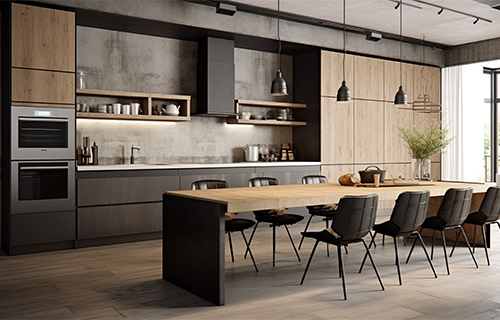Kitchen Design

Modern kitchen design is based on blending practical beauty with comfort and efficiency.
When choosing materials such as wood or aluminum, each has different features that meet specific needs and preferences. Here is a comprehensive comparison of wood and aluminum kitchens:
1. Wooden Kitchens:
Wooden kitchens add a warm and natural touch, making them a preferred choice for many who seek traditional elegance and comfort.Features:
- Natural Aesthetic: Wood offers a warm, organic look that can be easily customized through carving or painting.
- Versatile Styles: Wood can be used in a variety of designs ranging from classic and rustic to some modern styles.
- Strength and Durability: Solid wood is one of the most durable materials and is relied upon in kitchens.
- Repairable: If scratches or damage occur, wood can typically be repaired easily through polishing or sanding.
Disadvantages:
- Maintenance Requirement: Wood requires regular maintenance to stay in good condition, such as protection from moisture and scratches.
- Higher Cost: Wooden kitchens are often more expensive compared to other materials like aluminum.
- Moisture Sensitivity: Wood can be affected by moisture if not treated properly.
Types of Wood Used in Kitchens:
- Hardwood: Such as oak, mahogany, beech, and pine.
- Plywood: A less expensive option often used in areas that don’t require full strength.
2. Aluminum Kitchens:
Aluminum kitchens are characterized by their modern appearance and are an excellent choice for contemporary kitchens due to their durability and ease of maintenance.Features:
- Moisture and Heat Resistance: Aluminum is resistant to moisture and heat, making it an ideal choice in kitchen environments exposed to high humidity and steam.
- Low Maintenance: Aluminum does not require much upkeep and is not affected by weather conditions like wood.
- Corrosion and Rust Resistance: Aluminum is resistant to rust, a significant advantage in kitchens.
- Multiple Color Options: Aluminum comes in various colors and designs, allowing for diversity in appearance.
- Lightweight and Easy to Install: Aluminum is lightweight compared to wood, making installation easier.
Disadvantages:
- Less Thermal and Acoustic Insulation: Compared to PVC, aluminum may be less effective at thermal and sound insulation.
- Cool Appearance: Aluminum may lack the warmth that natural wood provides, as it tends to give a cold, industrial look.
- Limited Styles: While colors are diverse, the styles and textures that can be achieved with aluminum are limited compared to wood.
Comparison Between Wood and Aluminum:
| Aspect | Wooden Kitchens | Aluminum Kitchens |
|---|---|---|
| Aesthetic | Warm and natural | Modern and contemporary |
| Durability | Durable but requires maintenance | Durable and weather-resistant |
| Thermal and Acoustic Insulation | Good | Less effective |
| Cost | Generally higher cost | Typically lower cost |
| Maintenance | Requires regular maintenance | Low maintenance |
| Design Flexibility | Greater flexibility in carving and patterns | More color options than patterns |
Choosing the Right Option for You:
- If you seek a traditional or rustic appearance with good insulation and prefer a natural feel: Wooden kitchens are the best choice.
- If you prefer a modern kitchen that requires less maintenance, with high resistance to moisture and heat: Aluminum kitchens would be the ideal option.
